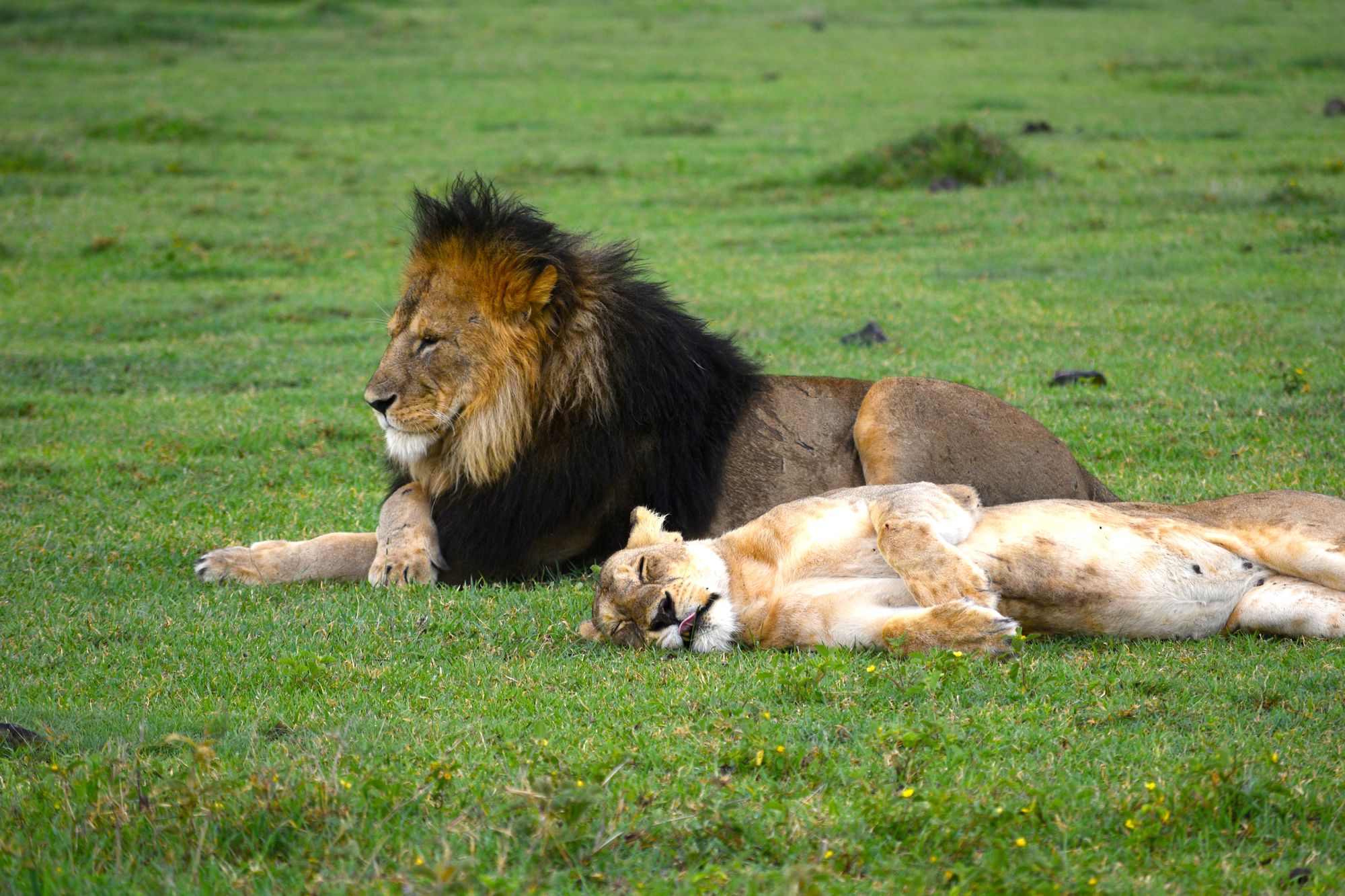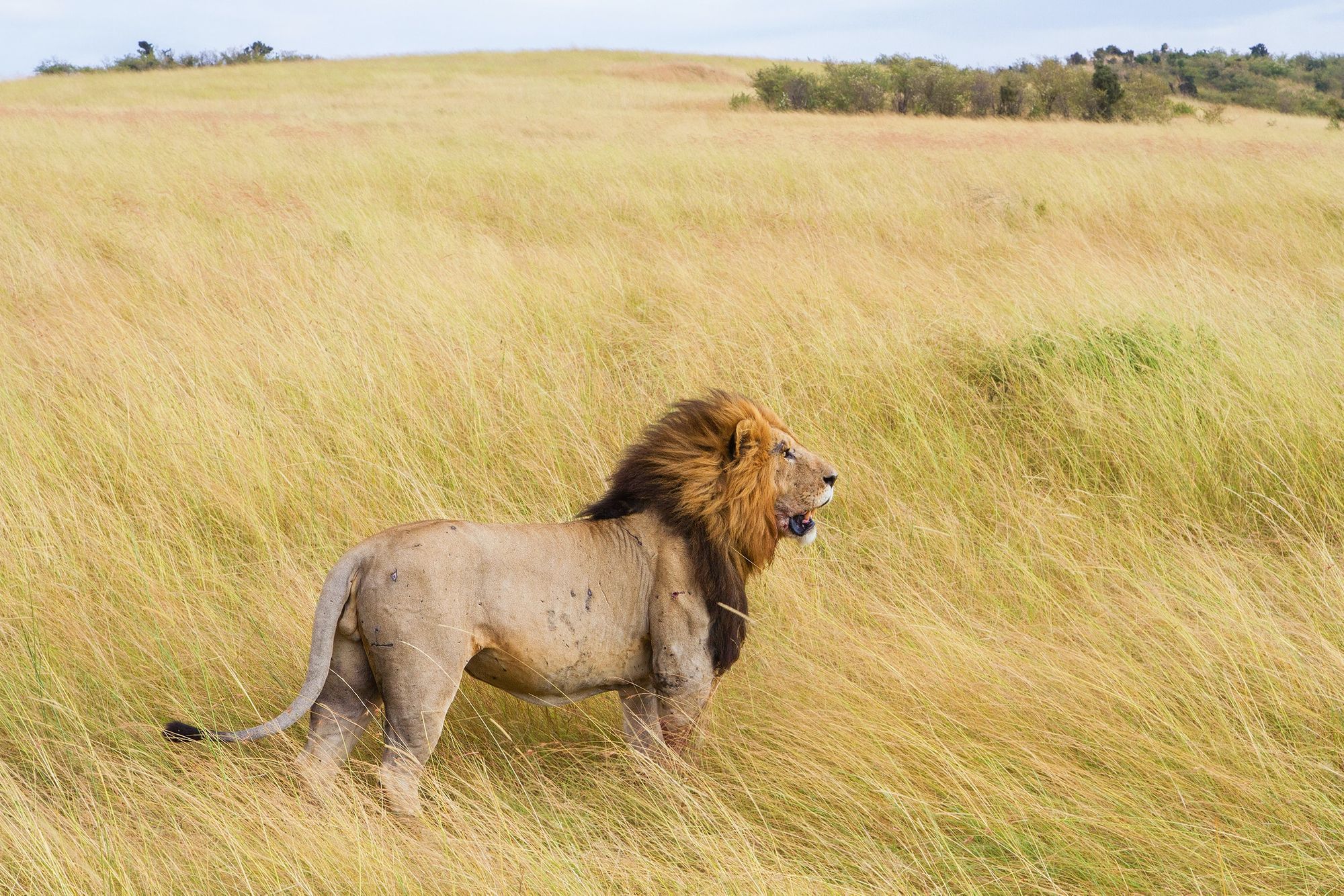How animals pay the price for their own survival in a world of burgeoning population growth
The tawny skins of a pair of mating lions, fast asleep in the deep shade offered by the low brush, caught our eye. As a group we gathered on our horses, close by but not too close by. This area of bush was known to harbor plenty of lions during the warm part of the day. Other safari goers were in Land Cruisers, and pulled up to see what might happen, cameras at the ready.
Nothing, happily. They slumbered on. Mating lions can repeat their sexual act every 20–30 minutes up to fifty times during a 24-hour period. They’d be together that whole time, usually, although the male might also be drawn off by another female in estrus.
We rode farther afield, nine of us, all clients of Offbeat Mara, which has a camp situated on the Mara River in this carefully-preserved party of the North Mara Conservancy in Kenya.
As we circled broadly around the next set of low brush we spotted a huge, handsome male with his lady love resting in the long shade of a tall olive tree. Simon Kenyon, our guide, rode ahead on Chulu, his spicy mare, closer in towards the lions, his bullwhip at the ready. She rose, and approached, not in attack mode, but out of curiosity. Our horses started nervously, but Simon told us to hold fast, and by all means not take off at the run.
When she got too close, he cracked the bullwhip in the air, and she backed off. The male stood, watching. At one point he approached, and snarled. Simon advised us to back up a bit and give them space. When he roared at us, like a short warning bark, we backed up more. They then ignored us and got back down to the serious business of making little lions.
We’d be returning after dark.
That night we would come back by Land Cruiser. Netty, the experienced Maasai spotter, sat atop the vehicle next to me as we drove the bouncy, rutted mud roads back to where we’d spotted the mating pair. This time we saw them in the headlights, the male following close on to the female to mount her again. The pairing lasted barely seconds, after which the lioness would roll on her back almost coquettishly, and reach her paws out, while the male stared at us. Sometimes they would roar at each other and bare their long fangs while mating, but it was all for show.
We shone the bright lights of our flashlights right into their eyes. They’re quite accustomed to the presence of cars like ours. And we were barely six or seven feet away.
Purists would howl. At first, this kind of invasion of their privacy, such as it is, offended my sensibilities, especially when other Land Cruisers drove up with more people shining more lights into their eyes. Honestly, I thought. How incredibly invasive.

Yet, as I spent more time in the Mara by horse, and more time in the Land Cruiser at night, at one point driving right next to a pride of nineteen lions dining on a freshly-killed giraffe, I realized that without our intrusion into their lives, there would be no lions at all.
Or zebra, or gazelle, or antelope, or wart hogs, or hippos, or hyenas or leopard or cheetahs. Just endless, overgrazed land, with millions of cows, goats, sheep. And people.
No more paradise.
In the last few years, the Maasai population surrounding the North Mara Conservancy has grown by four hundred percent. The pressure on the land to provide grazing for the huge cattle herds that the Maasai value (they use cattle to buy wives, and to show influence) is enormous. Time and again, Simon and others explained that unless the rich, fertile volcanic lands of the conservancy can be shown to be equally or more valuable to the Kenyan government than as arable land for its exploding population, the land will be lost and all the animals with it. The tourist industry would promptly vanish, and all the revenues associated with it. At this point, the tourist business continues to provide enough cash flow. And where we tourists travel to observe the game, the game populations have grown.
At 74,000 acres, it’s a tiny plot of paradise in an Africa where wildlife has been wiped clean off untold millions of acres.
To wit: In 2015, I rode a camel for seven days across Tanzania with four Maasai and a Meru man from Arusha to Lake Natrone. We saw one small herd of zebra. Seven days, one herd of zebra. Untold thousands of sheep, goats and cattle, and Maasai bomas. Trees were gone or stripped bare for firewood. Wiped clean.
The same thing has happened to the gorilla and chimp populations in Uganda and Rwanda, both of which I visited that same year, whose acclimation to humans has a far better chance of ensuring their future than any hands-off policy. Population growth continues to encroach on their feeding grounds, and tourists are often the only thing between them and extinction.
To wit: In 2018 I hiked Mt. Kenya, eight days, including three across vast open lands. In all that time, we saw one pair of antelope. Eight days of walking, one pair of antelope, miles and miles and miles of open territory. Wiped clean.
To wit: In 2019 I spent three and a half weeks in Ethiopia, including eight days’ riding in the Bale Mountains and the endless drive to the Danakil Depression. I saw two antelope, one red wolf and a secretary bird. The area is completely overrun with sheep, cattle and goats. Wiped clean.
What you see in photos of Africa of game is in very, very limited, carefully controlled areas. Africa is overrun with overpopulation, overcrowded cities and masses of grazing animals which have mowed the grasslands bare for the rest of Africa’s natural population. What’s left is teetering on a knife’s edge, threatened by poachers and villagers whose crops are invaded by animals whose lands were invaded by those villagers. Small villages are cropping up right now all over the outer edge of the Mara, which will cause all kinds of problems in the near future.
The uneasy alliance that now exists among the Maasai who graze the lands is working, for now, for most have seen the benefit of paying for access to good grazing. In 2017, a drought, which is an African fact of life, drove some pastoral herders to raid and set Offbeat’s buildings on fire and shoot the British founder, Tristan Voorspuy, to death. That set off shock waves in many circles, and while his family have continued the safari and conservation work, the realities of overpopulation and overgrazing continue to threaten the current peaceful arrangements which allow game to thrive in such a relatively small space.
So while in an ideal world, we would leave Eden alone, the lions to their love affairs and to their grisly feasts, without considerable tourist dollars those magnificent animals would simply disappear over camp fires as meals. But we don’t live in an ideal world. We do have enough dedicated people, Voorspuy among them, who are visionary enough to have established conservancies that allow us even the small bits of Eden that we do have. Otherwise, you and I would travel to Africa to see what I had seen for seven days in Tanzania: nothing but people, goats, sheep and cows. And the desperate poor, who stop tourist cars to demand a tax for the right to drive through their village.
To give you an idea of some of what the tourist business contributes towards conservation, Offbeat pays some $60k a year just for the concession to run its safaris and riding adventures. That’s equivalent to about $6m Kenyan shillings. Additionally, they and other Mara-based outfits like them pay rent for the campsites and/or hotel locations. Out of each $1000 per day that you and I pay for the safari itself, two hundred right off the top also goes to conservation for each and every rider, each and every day. Other tourists utilizing other services have similar percentages going towards conservation.
The rest of the money goes towards a huge set of operational costs, ranging from the horses and their upkeep, massive amounts of food, forty full-time and forty part-time staff, vehicles, tents, fuel, fresh water and much more. To put it into perspective, on a mobile safari, you are in effect moving an entire small village: housing (tents for you and staff), the supplies and grooms for the horses, food and supplies and tack, medical supplies and backup gear in the event of emergencies. It’s a major operation and goes on constantly in season.
Every time you and I purchase a high-end Kenyan safari with an operator in this area, we are better ensuring the future of the very cubs my group may have watched being brought to life. When that lioness gives birth, her cubs will be acclimated to the smell of humans, diesel fuel and the annoyance of bright lights being shone into their eyes while people watch their most intimate moments.
The price we pay to have even a tiny piece of paradise left to us, at least in this part of the world.
For my part, I would rather make the investment in the trip, if for no other reason than to be able to see what my investment is, in part, helping to preserve. There are few more compelling sights than to watch the mating dance of one of the fiercest and most beautiful animals on the face of the earth.
There is no more Born Free, as badly as we might wish it possible. However, as long as there are travelers passionate enough to see these great animals in what little wild there is left, there will be lions, leopards, cheetahs, elephants and all the rest to watch, admire and deeply appreciate, for generations to come.

Comments powered by Talkyard.